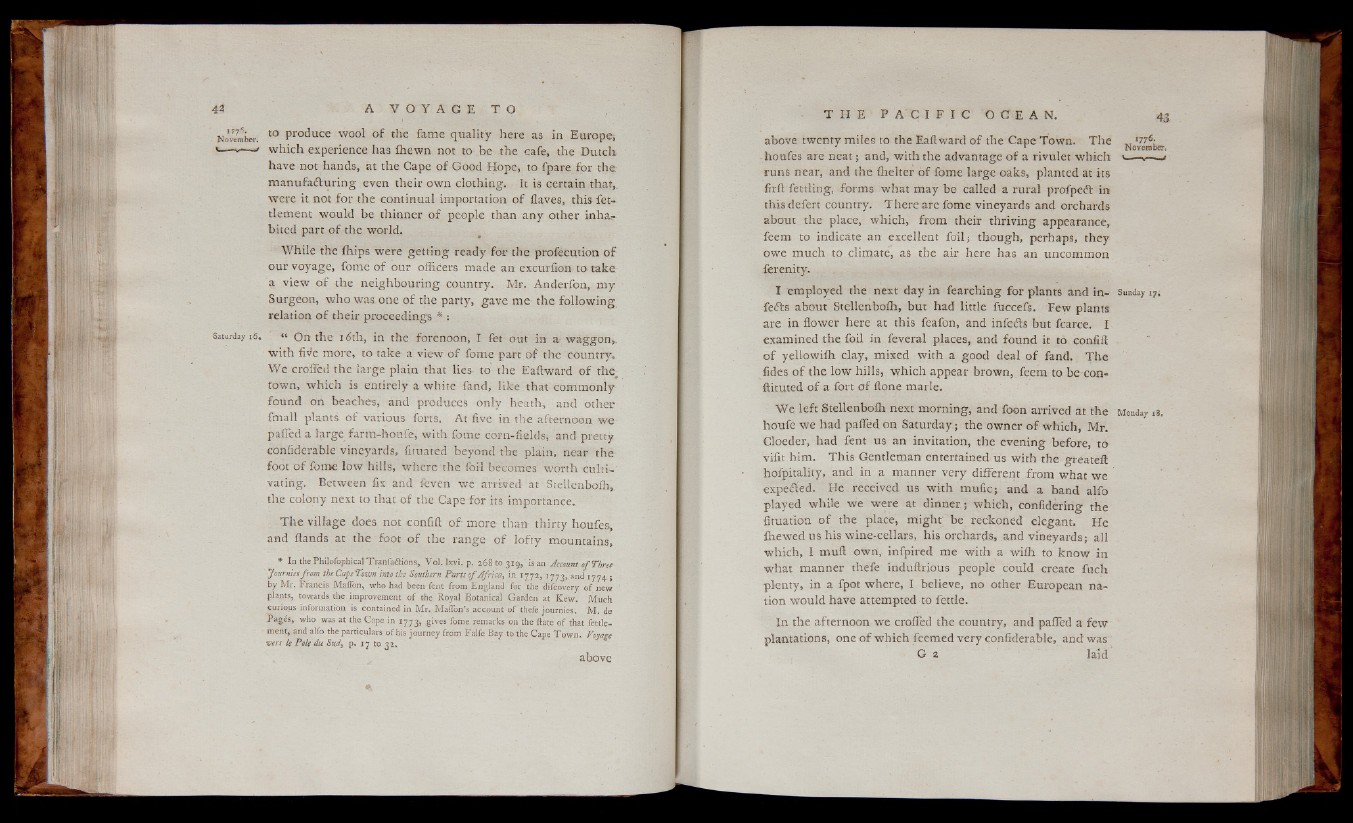
to produce wool of the fame quality here as in Europe;
which experience has ffiewn not to be the cafe, the Dutch;
have not hands, at the Cape of Good Hope, to fpare for the
manufacturing even their own clothing. It is certain that,
were it not for the continual importation of flaves, this fet-
tlement would be thinner of people than any other inha.-
bited part of the world.
While the fhips were getting ready for the profecution of
our voyage, forne of our officers made an excurlion to take
a view of the neighbouring country. Mr. Anderfon, my
Surgeon, who was one of the party, gave me the following
relation of their proceedings * :
“ On the 16th, in the forenoon, I fet out in a. waggon,
with five more, to take a view of fome part of the country.
We eroffed the large plain that lies to the Eaftward of tine
town, which is entirely a white fend, like that commonly
found on beaches, and produces only heath, and other
fin all plants of various forts. At five in the afternoon we
pafled a large farm-home, with fome corn-fields; and pretty
confiderable vineyards, fituated beyond the plain, near the
foot of fome low hills, where the foil becomes worth eulri-’
vating. Between fix and feven we arrived at Stellenboih,
the colony next to that of the Cape for its importance.
The village does not confift o f more than thirty houfe.%
and Hands at the foot of the range of lofty mountains,
* In the Philofophical Tranfa&ions, Vol. Jxvi. p. 268 to 315, is an Account o f Three
Journiet from the Capt Town into the Southern 'Parts o f Africa, in 17 7.2, 1773,.and 1774 ;
by Mr. Francis Maflon, who had been lent from England for the dilcovery of new
plants, towards the'improvement o f the Royal Botanical Garden at Kew. Much
curious information is contained in Mr. MaiTon’s account of thefe jpurmes'. M. de
Pages, who was at the Cape in 17.73, g 'ves fome remarks on the ftate o f that fettle-
ment, and alfo the particulars, of his journey from Falfe Bay to. the Cape Town. Voyage
vers le Pole du Sttd3 p. 17 to 32.
above twenty miles to the Eaftward of the Cape Town. The ,, W5; r IS ovetn brr,
houfes are neat; and, with the advantage of a rivulet which >, —,— i
runs near, and the fhelter of fome large oaks, planted at its
firft fettling, forms what may be called a rural profpeth in
this defert country. There are fome vineyards and orchards
about the place, which, from their thriving appearance,
feem to indicate an excellent foil; though, perhaps, they
owe much to climate, as the air here has an uncommon
ferenity,
I employed the next day in fearching for plants and in- Sunday 17;
fefts about Stellenboih, but had little fuccefs. Few plants
are in flower here at this feafon, and infefts but fcarce. I
examined the foil in feveral places, and found it to confift
of yellowiffi clay, mixed with a good deal of fend. The
fides of the low hills, which appear brown, feem to be-con-
ftituted of a fort of ftone marie.
We left Stellenboih next morning, and foon arrived at the Monday 18.
houfe we had paffedon Saturday; the owner of which, Mr.
Cloeder, had fent us an invitation, the evening before, to
vifit him. This Qentleman entertained us with the greateft
hofpitality, and in a manner very different from what we
expe&ed. He received us with mufic; and a band alfo
played while we were at dinner.; which, confidering the
fifuation of the place, might be reckoned elegant. He
fhewed us his wine-cellars, his orchards, and vineyards; all
which, I muft own, infpired me with a wiih to know in
what manner thefe induftrious people could create fuch
plenty, in a fpot where, I believe, no other European nation
would have attempted to fettle.
In the afternoon we croffed the country, and paffed a few
plantations, one of which feemed very confiderable, and was
G 2 laid